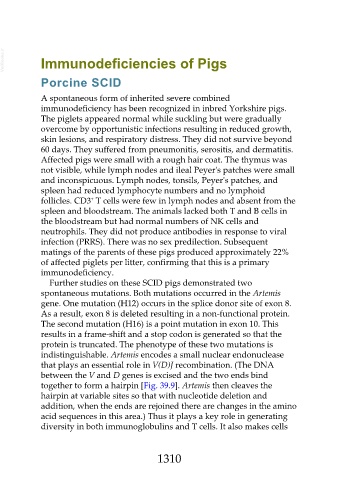Page 1310 - Veterinary Immunology, 10th Edition
P. 1310
VetBooks.ir Immunodeficiencies of Pigs
Porcine SCID
A spontaneous form of inherited severe combined
immunodeficiency has been recognized in inbred Yorkshire pigs.
The piglets appeared normal while suckling but were gradually
overcome by opportunistic infections resulting in reduced growth,
skin lesions, and respiratory distress. They did not survive beyond
60 days. They suffered from pneumonitis, serositis, and dermatitis.
Affected pigs were small with a rough hair coat. The thymus was
not visible, while lymph nodes and ileal Peyer's patches were small
and inconspicuous. Lymph nodes, tonsils, Peyer's patches, and
spleen had reduced lymphocyte numbers and no lymphoid
+
follicles. CD3 T cells were few in lymph nodes and absent from the
spleen and bloodstream. The animals lacked both T and B cells in
the bloodstream but had normal numbers of NK cells and
neutrophils. They did not produce antibodies in response to viral
infection (PRRS). There was no sex predilection. Subsequent
matings of the parents of these pigs produced approximately 22%
of affected piglets per litter, confirming that this is a primary
immunodeficiency.
Further studies on these SCID pigs demonstrated two
spontaneous mutations. Both mutations occurred in the Artemis
gene. One mutation (H12) occurs in the splice donor site of exon 8.
As a result, exon 8 is deleted resulting in a non-functional protein.
The second mutation (H16) is a point mutation in exon 10. This
results in a frame-shift and a stop codon is generated so that the
protein is truncated. The phenotype of these two mutations is
indistinguishable. Artemis encodes a small nuclear endonuclease
that plays an essential role in V(D)J recombination. (The DNA
between the V and D genes is excised and the two ends bind
together to form a hairpin [Fig. 39.9]. Artemis then cleaves the
hairpin at variable sites so that with nucleotide deletion and
addition, when the ends are rejoined there are changes in the amino
acid sequences in this area.) Thus it plays a key role in generating
diversity in both immunoglobulins and T cells. It also makes cells
1310

